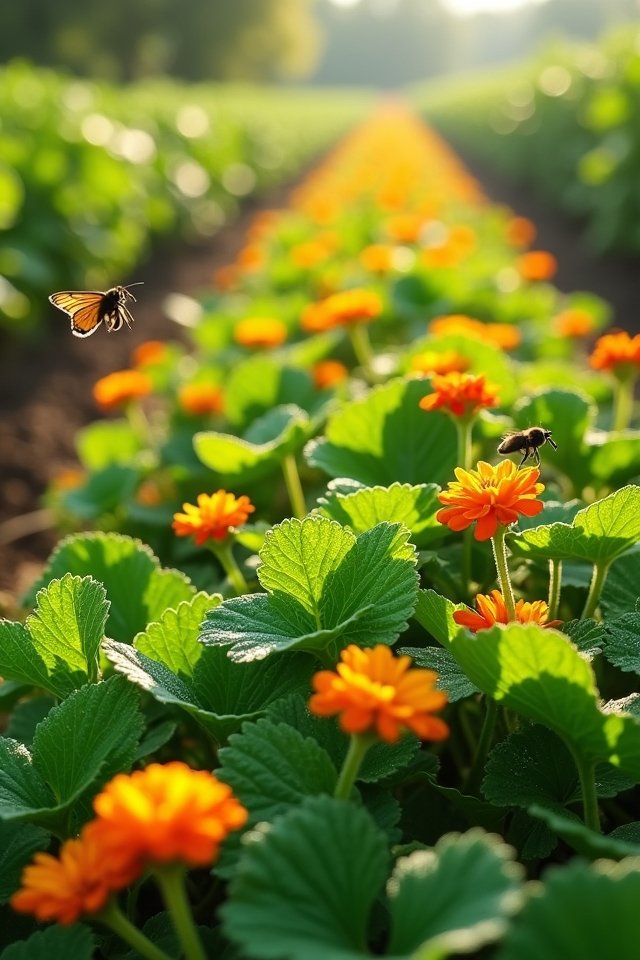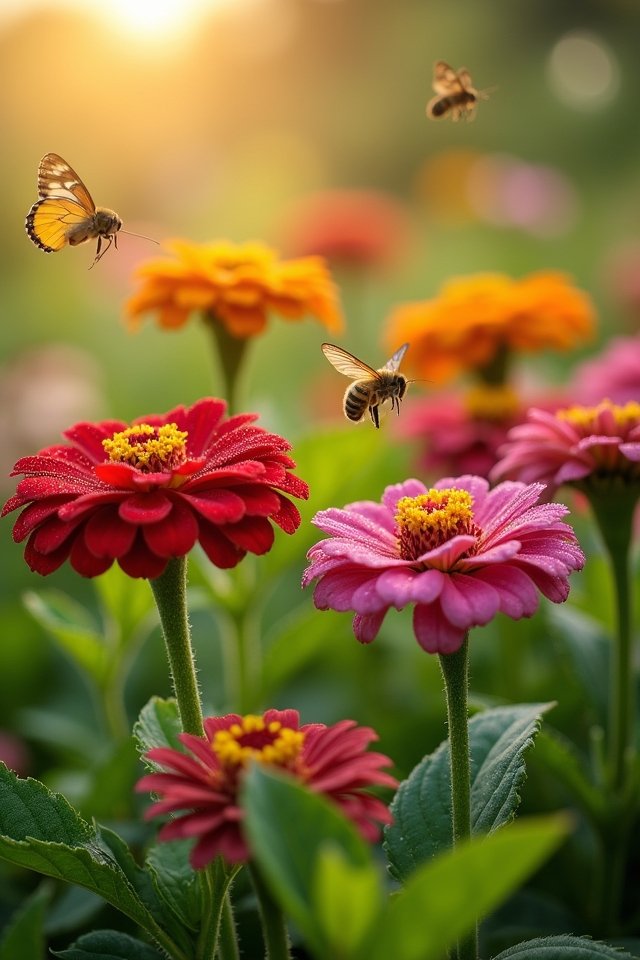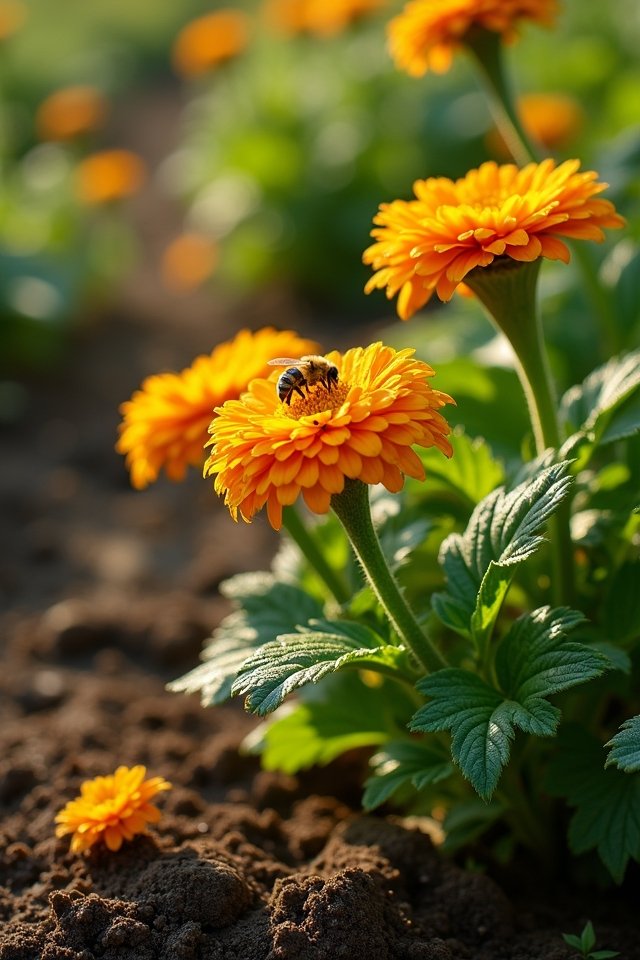Looking to jazz up your veggie garden? Marigolds are fabulous for deterring pesky aphids while adding bursts of sunny color! Nasturtiums invite helpful insects like ladybugs, while sunflowers tower above, attracting pollinators that boost your harvest. Borage brings a revitalizing cucumber taste and nutrients to your soil! Don’t forget zinnias, which charm bees and butterflies, or calendula, effective against aphids with its bright blooms. Want to uncover even more floral friends for your veggies? Keep exploring!
Marigolds: Pest Deterrents and Soil Enhancers

When you plunge into the vibrant world of gardening, you might wonder how to keep those pesky pests at bay while giving your veggies a boost. Enter marigolds! These bright orange and yellow flowers aren’t just eye candy; they’re also fantastic pest repellents. Plant them alongside your tomatoes, and you’ll notice fewer aphids in no time. Plus, as they bloom, marigolds release compounds that improve soil nutrients—like a helpful little fertilizer! Imagine your garden bursting with color while thriving veggies soak up all the goodness. Talk about a win-win! So, the next time you spot pests making themselves at home, just remember: a few marigolds can change the game. Let your garden flourish with these clever companions!
Nasturtiums: Attracting Beneficial Insects

Imagine strolling through your garden, where vibrant nasturtiums bloom like little suns, beckoning beneficial insects to join the party! These cheerful flowers aren’t just pretty faces; they’re nature’s own invitation to ladybugs and lacewings. These friendly critters love snacking on pesky aphids, helping your vegetables thrive. Plus, nasturtiums’ deep roots enhance soil health, making your garden more resilient!
As you plant these beauties, think of them as nature’s confetti, celebrating a vibrant ecosystem. You’ll notice fewer pests and a flourishing space, like a well-choreographed dance of life. So, why not add some nasturtiums to your plot? They’re not just companions; they’re heroes in disguise, turning your vegetable garden into a buzzing paradise! How’s that for innovative gardening?
Sunflowers: Maximizing Space and Attracting Pollinators

As you step into your garden, the towering sunflowers stand proud, their golden faces turning toward the sun like cheerful sentinels of summer! These magnificent blooms not only maximize space but also attract an enthusiastic crowd of pollinators. Ready to plant sunflowers? Here are three fantastic benefits:
- Sunflower varieties: Experiment with dwarf types for small spaces or giant varieties as stunning focal points.
- Natural pest deterrents: Their height and leaves can help shield veggies while attracting beneficial insects.
- Mutual growth boost: Companion planting sunflowers with crops like tomatoes can enhance yield!
Borage: Boosting Growth and Flavor

If you’ve ever wished for a secret weapon in your vegetable garden, seek no further than borage! This vibrant blue flower isn’t just pretty; its borage benefits extend to boosting the growth and flavor of your veggies. Imagine plump tomatoes and zesty cucumbers flourishing alongside charming borage, as its leaves release nutrients into the soil! You’ll love how borage uses include deterring pests and attracting pollinators, giving your garden a lively ecosystem. Plus, those borage leaves? They make a fantastic addition to salads, adding a cucumber-like taste! So go ahead, plant borage in your garden and watch the magic unfold. Who knew flowers could be such incredible allies? It’s time to elevate your garden game with borage!
Zinnias: Colorful Companions for Pollinator Attraction

Brighten up your garden with zinnias, those cheerful blooms that’ll have the pollinators buzzing in no time! These vibrant flowers not only add delightful color but also attract bees and butterflies, enhancing your vegetable garden’s ecosystem. Want to know why zinnias are the ultimate companions? Check this out:
- Variety Galore: With zinnia varieties like ‘Queen Lime’ and ‘Zinderella’, you’ll find colors that pop and contrast beautifully with your veggies!
- Easy Zinnia Care: Just a bit of sun, well-drained soil, and regular watering are all you need for these resilient beauties.
- Attracting Magic: Pollinators flock to zinnias faster than kids to candy, ensuring your garden thrives!
Get ready for nature’s lively party in your backyard!
Calendula: Supporting Healthy Growth and Pest Control

When you plant calendula in your vegetable garden, you’re not just adding a splash of sunny color—you’re inviting a loyal ally against pesky pests! These bright blossoms are like tiny, cheerful warriors, fighting off aphids and other unwanted critters. But wait, there’s more! Calendula benefits your crops by attracting beneficial insects, like bees and ladybugs. As a companion planting superstar, it boosts your plants’ health by improving soil quality and providing shade. Plus, its aroma seems to confuse harmful pests—what a sneaky trick! So, why not enhance your garden’s diversity and beauty? Cultivate calendula alongside your tomatoes and peppers, and watch them flourish together. Your veggies will thank you with lush growth and vibrant yields! Isn’t nature just fantastic?
Frequently Asked Questions
Can Companion Flowers Help With Soil Health in Vegetable Gardens?
Ever wonder how a splash of color could transform your garden’s health? Companion flowers can work wonders! They attract beneficial soil microorganisms, sparking nutrient cycling like magic! Imagine bright marigolds inviting friendly bugs that help break down organic matter, enriching your soil with their festive blooms. Plus, those cheerful petals can deter pesky pests! So, yes, adding these beauties isn’t just for looks—your veggies will thank you with bigger, tastier harvests! Isn’t that exciting?
What Are the Best Planting Techniques for Companion Flowers?
When you’re thinking about planting techniques for flowers, consider spacing like a dance floor! You want each flower to have room to twirl—about 12 to 18 inches apart is ideal. Mixing heights adds drama, so plant taller varieties behind shorter ones. Try interspersing colors to create a vibrant tapestry! Don’t forget to stagger your blooms, attracting more pollinators. With these snazzy techniques, your garden will not only look fabulous but thrive like a rock star!
How Do I Choose Companion Flowers for My Specific Vegetables?
Choosing companion flowers for your veggies can feel like matchmaking on a grand scale! How do you pick the perfect partners? Start with flower selection tips: look for blooms that attract beneficial insects. For example, marigolds charm away pesky pests while zinnias invite butterflies! Consider vegetable compatibility; sunflowers love hanging out with tomatoes. So, make your garden a dazzling social scene—those carrots and nasturtiums will thank you with abundant harvests and vibrant colors!
Are There Any Companion Flowers That Are Invasive?
Some companion flowers can be invasive species, just like that overly friendly neighbor who takes over the block party! Flowers like purple loosestrife or yellow flag iris can create fierce competition for nutrients and space. You don’t want your garden resembling a chaotic jungle! Stick to non-invasive beauties like marigolds or zinnias, which add vibrant colors and beneficial insects without becoming unwelcome guests. Your veggies will thank you!
How Can I Optimize Companion Flower Placement for Maximum Benefit?
To optimize flower placement, think of it as a dance! Use flower positioning strategies that harmonize seasonal blooming patterns. For instance, pairing bright marigolds with tender tomatoes creates a lively trio. Imagine the rich colors and delightful scents! Space blooms every few rows, letting them mingle openly. They’ll attract pollinators while repelling pests—it’s a win-win! So, why not let your garden inspire its own blooming symphony? Your veggies will thank you!


